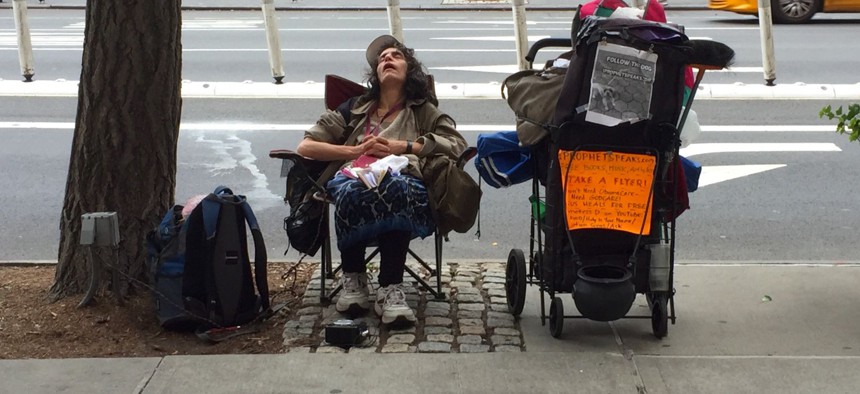‘Being Housed Does Not Alleviate All of the Other Poverty Needs That People Have’

Shutterstock
The U.S. Conference of Mayors released its annual Hunger and Homelessness Survey, examining the challenges that cities continue to grapple with.
Mayor Helene Schneider of Santa Barbara, California, points to a few main reasons why hunger persists as a problem in U.S. cities.
“We can look to low wages that are paid to our citizens, as well as the high housing costs and poverty,” she said during a conference call with reporters on Wednesday, as she and others discussed a newly released survey of hunger and homelessness in cities around the nation.
The mayor noted that about half the people the survey found to be requesting emergency food assistance are employed. “They are working,” she said. “We’re talking about the working poor.”
Schneider chairs the U.S. Conference of Mayors task force on hunger and homelessness. The Conference of Mayors on Wednesday released its annual Hunger and Homelessness Survey, a report the organization first began issuing in the early 1980s.
“We did not believe that we’d still be conducting surveys on hunger and homelessness when we started this in ’83,” said Tom Cochran, CEO and executive director of the Conference of Mayors. “But here we are today investigating two age-old problems that still trouble our nation’s cities.”
A total of 32 cities, located in 24 states were included in the analysis of homelessness in the survey. The hunger portion is based on responses from 17 jurisdictions—although some didn’t respond to all of the survey questions.
Given the limited number of cities it looks at, the annual report is only meant to provide a snapshot of homelessness and hunger around the U.S. It is not designed to be a representative sample of what’s going on in all urban areas across the country, or to serve as a comprehensive national report on hunger and homelessness.
The number of people considered to be homeless nationwide has been declining in recent years, dropping by about 13 percent between 2009 and 2016, according to the report. But, on a single night in January this year, at least 544,084 were homeless in the U.S., the report says. Of those people, 171,520, or close to one-third of the total figure, were in cities examined in the survey.
Overall among the survey cities, 51 of every 10,000 people in the general public were experiencing homelessness, the report says. Rates for individual cities ranged from 11 people per 10,000 in Wichita, Kansas, to 124 people per 10,000 in Washington, D.C.
On the hunger front, 41 percent of cities surveyed reported that the number of requests for emergency food assistance had gone up during the last year. Of the people requesting food aid, 63 percent were people in families, 18 percent were elderly and 8 percent were homeless.
Mirroring Schneider’s remarks, low wages topped the list of causes of hunger cited by surveyed cities, followed by high housing costs and poverty.
“Being housed does not alleviate all of the other poverty needs that people have,” Samantha Batko, director of the Homelessness Research Institute at the National Alliance to End Homelessness, said during Wednesday’s conference call.
The Alliance collaborated with the U.S. Conference of Mayors on this year’s Hunger and Homelessness Survey.
Batko added that the amount of people spending more than 50 percent of their income on housing has gone up since the Great Recession. In light of that, she said she does not find it surprising people continue to struggle with hunger, even if they’re not homeless.
A bright spot in the findings presented in the new report was that veteran’s homelessness decreased in at least 23 of the cities surveyed between 2009 and 2016.
As for how the incoming administration of President-elect Trump might affect work to eliminate homelessness and hunger in cities, Schneider said it’s an open question.
“There looks to be some kind of shift in philosophy, but we don’t know that,” she said.
“Cities are going to come together and do what they can,” Schneider added. “But that partnership with federal agencies and that collaborative effort is so crucial to find success.”
Bill Lucia is a Reporter for Government Executive's Route Fifty and is based in Washington, D.C.
NEXT STORY: The Creepy Beauty of Flying Over North Dakota Fracking Country at Night






